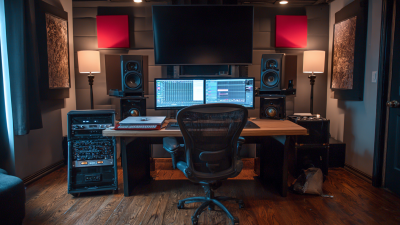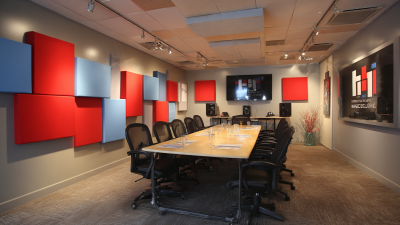In today's world, where high-quality audio is paramount for both entertainment and productivity, understanding the intricacies of sound management has become increasingly important. One significant solution that many homeowners and enthusiasts are turning to is Acoustic Sound Panels. These specially designed panels are engineered to absorb, diffuse, and reflect sound waves, effectively enhancing audio clarity within any space.

By reducing echo and minimizing unwanted noise, Acoustic Sound Panels not only improve the overall sound quality but also contribute to a more enjoyable listening environment. This article delves into the science behind these panels, exploring various types and materials, and how they can be strategically implemented to optimize sound in homes.
Whether you are a musician, a home theater aficionado, or simply someone who values a serene atmosphere, understanding how Acoustic Sound Panels work can greatly enhance your audio experience.
When it comes to enhancing the audio quality in your home, selecting the right material for acoustic sound panels is crucial. There are various types of materials available, each with unique properties that affect sound absorption and diffusion. For instance, fiberglass and foam are popular choices due to their lightweight nature and high sound absorption coefficients. Fiberglass panels are particularly effective in high-frequency sound control, while foam panels can mitigate mid-range frequencies, making them suitable for different audio setups.
Another significant material option is wood, which not only provides aesthetic appeal but also helps in sound diffusion. Wood acoustic panels can reduce echo while maintaining a natural warmth in sound. Additionally, fabric-wrapped panels offer a versatile solution, allowing you to customize colors and textures to fit your home decor while enhancing acoustic performance. Understanding the characteristics of these materials will empower you to make informed decisions tailored to your specific auditory needs, ultimately elevating your home audio experience.
| Material Type | NRC Rating | Best Use Cases | Thickness (inches) | Price Range (per panel) |
|---|---|---|---|---|
| Polyester Fiber | 0.95 | Home Theaters, Recording Studios | 1-2 | $30 - $60 |
| Acoustic Foam | 0.85 | Music Rooms, Dance Studios | 2-4 | $20 - $40 |
| Mineral Wool | 1.00 | Commercial Spaces, Offices | 2-6 | $50 - $100 |
| Fabric Wrapped Panels | 0.90 | Theaters, Conference Rooms | 1-3 | $40 - $80 |
| Wooden Panels | 0.70 | Living Rooms, Home Offices | 0.75-2 | $60 - $150 |
When it comes to enhancing audio quality in a home setting, the size of your acoustic panels plays a crucial role in their effectiveness. Larger panels typically absorb lower frequencies better, which is essential for achieving a well-balanced sound. To optimize the sound absorption capabilities, it's important to consider the dimensions of the panels in relation to the size of the room. A larger room may require larger or multiple panels strategically placed to mitigate echoes and reverberation, while smaller spaces can benefit from smaller, denser panels that target specific problem areas.
In addition to size, the placement of acoustic panels is equally significant. For maximum sound absorption, panels should be installed at the first reflection points in the room, usually on the walls and ceiling. These locations can greatly improve sound clarity by reducing unwanted reflections that muddy the audio experience. Incorporating a mix of panel sizes can create a more versatile sound treatment, allowing for targeted absorption of both high and low frequencies. Balancing aesthetics and functionality will ensure that your acoustic treatment not only enhances sound quality but also complements the overall design of your space.

Strategic placement of acoustic panels is essential for achieving optimal audio quality in any home environment. These panels, designed to absorb sound waves, can significantly reduce unwanted noise and improve sound clarity. To maximize their effectiveness, consider placing them at first reflection points—areas where sound bounces off walls and reaches your ears. This strategic approach not only enhances listening experiences but also creates a more comfortable living space.
Tips for effective placement include assessing your room layout and identifying surfaces that reflect sound, such as nearby walls and ceilings. Installing panels in corners can also help combat low-frequency issues, while positioning them at ear level on walls will effectively absorb mid and high frequencies. Additionally, blending aesthetic appeal with functionality, acoustic panels are available in various designs that can complement your home decor.
Another consideration is the use of dual-purpose acoustic solutions that serve both sound absorption and aesthetic enhancement. Opt for panels that can be integrated into your interior design, creating a visually pleasing environment that doesn’t sacrifice audio quality. With thoughtful placement and innovative designs, you can transform your home into a sanctuary of superior sound.

When considering the effective use of acoustic sound panels in home audio, understanding the frequency range’s impact on panel effectiveness is crucial. Sound panels function best in a targeted frequency range, usually between 250 Hz to 2000 Hz, where most speech and music reside. According to a report by the Acoustic Society of America, optimizing these panels can reduce reverberation and enhance clarity in audio playback significantly, making it vital to choose materials that absorb sound effectively within this range.
Tips: For best results, opt for panels made from high-density fiberglass or mineral wool, which are shown to be more effective in sound absorption across the critical frequencies. Additionally, consider the thickness of the panels; those measuring 2 inches or more usually yield improved bass absorption, as stated in research from the National Institute of Standards and Technology.
Placement also plays a significant role. To maximize sound quality, install panels at reflection points—typically, areas where sound waves bounce off surfaces. Proper placement can enhance audio clarity and improve the overall listening experience, as highlighted in a study by the Journal of Architectural Acoustics. By understanding and leveraging frequency ranges, you can ensure that your home audio setup sounds its best.
When it comes to improving home audio quality, one of the pivotal decisions is whether to invest in DIY or professional acoustic panels. DIY acoustic panels can be an attractive option for those looking to save money while still achieving decent sound absorption. By using readily available materials like mineral wool, plywood, and fabric, enthusiasts can design and build panels tailored to their specific needs and aesthetic preferences. That said, the effectiveness of DIY solutions often depends on one's understanding of acoustic principles, as improper construction can lead to suboptimal sound treatment.
On the other hand, professional acoustic panels offer a level of expertise and material quality that may be hard to replicate at home. These panels are typically engineered with precise density and thickness to optimize sound absorption across various frequencies. Some may even incorporate advanced features like diffusion elements to balance sound reflections. While the initial investment may be higher, the result is often a more polished and effective sound environment, making it a worthwhile consideration for serious audiophiles or those looking to enhance their home theater experience. Choosing between DIY and professional acoustic panels ultimately hinges on budget, skill level, and personal audio ambitions.






